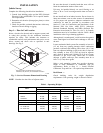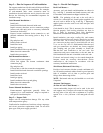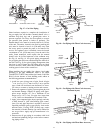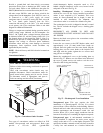
12
PositioningonCurb—
Position unit on roof curb so that the following clearances
are maintained:
1
/
4
in. (6.4 mm) clearance between the
roof curb and the base rail inside the front and back, 0.0
in. clearance between the roof curb and the base rail
inside on the duct end of the unit. This will result in the
distance between the roof curb and the base rail inside on
the condenser end of the unit being approximately equal
to Fig. 4 and Fig. 5, section C--C.
Although unit is weatherproof, guard against water from
higher level runoff and overhangs.
Flue vent discharge must have a minimum horizontal
clearance of 4 ft (1220 mm) from electric and gas meters,
gas regulators, and gas relief equipment. Minimum
distance between unit and other electrically live parts is
48 inches (1220 mm).
Flue gas can deteriorate building materials. Orient unit such
that flue gas will not affect building materials. Locate
mechanical draft system flue assembly at least 48 in. (1220
mm) from an adjacent building or combustible material.
NOTE: Installation of accessory flue discharge deflector
kit will reduce the minimum clearance to combustible
material to 18 in. (460 mm).
After unit is in position, remove rigging skids and
shipping materials.
Step 7 — Convert to Horizontal and Connect
Ductwork (when required)
Unit is shipped in the vertical duct configuration. Unit
without factory--installed economizer or return air smoke
detector option may be field--converted to horizontal ducted
configuration. To convert to horizontal configuration,
remove screws from side duct opening covers and remove
covers. Using the same screws, install covers on vertical
duct openings with the insulation--side down. Seals around
duct openings must be tight. See Fig. 8.
C06108
Fig. 8 -- Horizontal Conversion Panels
Field--supplied flanges should be attached to horizontal
duct openings and all ductwork should be secured to the
flanges. Insulate and weatherproof all external ductwork,
joints, and roof or building openings with counter flashing
and mastic in accordance with applicable codes.
Do not cover or obscure visibility to the unit’s informative
data plate when insulating horizontal ductwork.
Step 8 — Install Outside Air Hood
Economizer and Two Position Damper Hood
Package Removal and Setup -- Factory Option
1. The hood is shipped in knock--down form and must be
field assembled. The indoor coil access panel is used as
the hood top while the hood sides, divider and filter are
packaged together, attached to a metal support tray us-
ing plastic stretch wrap, and shipped in the return air
compartment behind the indoor coil access panel. The
hood assembly’s metal tray is attached to the basepan
and also attached to the damper using two plastic tie--
wraps.
2. To gain access to the hood, remove the filter access
panel. (See Fig. 9.)
FILTER ACCESS PANEL
INDOOR COIL ACCESS PANEL
C10146
Fig. 9 -- Typical Access Panel Locations
3. Locate the (2) screws holding the metal tray to the
basepan and remove. Locate and cut the (2) plastic
tie--wraps securing the assembly to the damper. (See
Fig. 10) Be careful to not damage any wiring or cut
tie--wraps securing any wiring.
Hood Parts
Plastic Tie Wrap
Qty (2)
Screws for Metal Tray
Qty (2)
C08639
Fig. 10 -- Economizer and Two--Position Damper
Hood Parts Location
581J


















